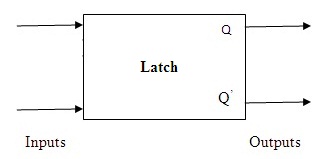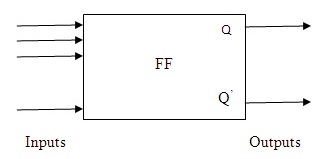In Digital Electronics, transmission and the storage of the data is the wide part of the computation. In both digital and informational technology sector data needs to be stored in the memory may be internal as in microcontroller or external as in micropocessors. To store the information in terms of bits the Latches and Flip-Flops are used. These are the basic storage elements that store binary values that are 0 and 1. Flip-Flop circuit is derived from the latch.
Both elements belong to the category of sequential circuits. These are designed by using logic gates. It differs from the response they produce based on the applied inputs and the control signals . The latches are sensitive to the level triggering whereas the flip-flops are edge-triggered. Latches require more attention when used in the circuits as they respond for every single change in the input.
What is a Latch?
A Latch is a memory element. It is formed by the interconnection of logic gates. The circuit of the latch is independent of the clock signal. Instead of the clock, it possesses the Enable signal. If the circuit is enabled and the inputs are provided the change in the states at the output is observed.

Latches (Block Diagram)
Further, change in the input without enabling the circuit there is no change at the output states noticed. This type of latches is known as Gated Latches. These are also referred to as Asynchronous circuits because the output is solely dependent on the applied input with modes of enabling and disabling.
What is Flip-Flop?
The latches with the clock signal provided are known as Flip-Flops. These are the synchronous sequential circuits because the clock signal controls the operations. It has only two stable states 1 and 0. It can have multiple inputs but produces only two outputs. In this circuit element, the edge of the signals creates an impact on the output. Hence it is an Edge Triggered circuit.

Flip-Flops (Block Diagram Clocked Latches)
What are the Differences between Latches and Flip-Flops?
The sequential circuits Latches and Flip-Flops are differentiated as
|
Latch |
Flip-Flops |
|
1. A Latch is known as ‘Asynchronous Sequential Circuit’. |
1. A Flip-Flop is a Synchronous Sequential Circuit. |
| 2. For any change in the input when the circuits are enabled, there is an instant change at the output. The output state change is dependent upon the duration of the pulse. | 2. The change in the output is dependent on the clock signal applied and that to the Falling and Rising Edge of the pulses. |
| 3. These are made up of logic gates. | 3. The flip-flops are made by applying the clock to the latches. |
| 4. The area required by the latches is less. | 4. The area required by the flip-flops is more comparable to that of a latch. Because a basic Flip-Flop minimum consists of two latches. |
| 5. The operations in the latch can occur fast. | 5. The operations to execute take some time because there is a certain delay to achieve sync. Hence the operations speed becomes slow. |
| 6. It requires the tools, as well as hand, made calculations to verify the time at which the output is obtained. | 6. Based on the Static Tools its timing diagram can be analyzed. |
| 7. The data can be transmitted as long as possible until the input switch remains in the ON state. | 7. The change in the output state depends upon the change in the applied clock signal. |
Please refer to this link to know more about Latches MCQs
FAQ’s
1. What does latching mean?
A Latch that holds the information in the form of bits which possess two inputs and produces one output that is either set or reset. The operation performed by these latches is termed as latching.
2. Why are Flip-Flops better than Latches?
The clock signal applied to the latch makes a flip-flop. This results in obtaining the synchronous behavior of the circuit. The change in the output state is controlled and depends upon the clock signal. The analysis of the timing diagrams of such flip-flops is done with the help of certain tools. Hence the circuits of flip-flops are better than latches.
3. Why Flip-Flop is called a Latch?
A flip-flop is made up of latches as the basic building blocks. But the difference is the change in the input state basing on the clock signals. When two latches are present in a single flip-flop if one latch is enabled high the other will be at a low state. This behavior of flip and flop of output states without the interference of clock transitions can be done by Enable signals. Hence a flip-flop is referred to as the latch.
4. What is the purpose of Latch?
The circuit that is designed by using logic gates which is capable of storing the bit information is known as the latch. The main purpose of this latch is to respond frequently to the changes in the input like a D-latch used in input/output ports.
Please refer to this link to know more about Flip Flop MCQs
Instead of latches, the Flip-Flops can be used as a Register. The reason is latch is sensitive to the change in the input state. This makes the circuit unstable. The present generation computers prefer a common clock signal to perform the operations. So, it uses flip-flops over latches. But why Clock signal is used in flip-flops?